

To receive future blogs, click ‘Follow blog‘ in left-hand menu
Comments closedpoetry, philosophy, work and play
I must start by apologising for the long gap between my last blog and this one. Life has been, indeed still is, extremely full and exciting; but I did say I would try to share a blog every few months. So here is the latest.
I recently had the great pleasure of attending a performance of Duke Ellington’s Sacred Jazz Concert, when Guildford’s concert hall, GLive, was packed to capacity. The series of songs and jazz pieces were composed by Ellington over a number of years and now form an impressive modern variation on the idea of an oratorio.
Jeremy Backhouse conducted the Vivace Chorus, which I last heard perform when I read some of my own poetry at their May concert last year. For this event, the choir was considerably larger than on that occasion, but even with the increased numbers they showed great versatility and control as they swung from energetic to peaceful and back, bringing life and force to the themes of praise, freedom and the majesty of God.

The soloist for this performance was Joanna Forbes L’Estrange, whom I happen to have known since she was a small girl. Now at the peak of her career, she has breath-taking talent and style, and personally I should be happy to listen to her for hours on end. As well as a long list of appearances, first as a member of the Swingle Singers when she was younger, and more recently as a highly sought-after soloist in her own right, she is also a composer of some renown, and has composed a celebratory anthem for the forthcoming coronation, ‘The mountains shall bring peace’.
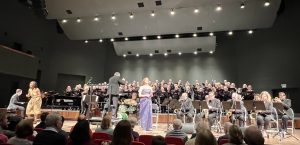 I have always said that I adore all dance, with the single exception of tap dance; but following this Duke Ellington concert I have had to adjust my position and abandon my prejudice, because the tap dancer, Annette Walker, was nothing short of phenomenal. Interpreting several of the movements, she brought what was already a superb performance to glittering life, with dance that, while it was certainly tap dance, also often appeared to be akin to contemporary dance. One of the movements was entitled ‘David danced’, in which the chorus, jazz band and tap dance melded beautifully; but we were treated to her exquisite interpretations in several other movements as well.
I have always said that I adore all dance, with the single exception of tap dance; but following this Duke Ellington concert I have had to adjust my position and abandon my prejudice, because the tap dancer, Annette Walker, was nothing short of phenomenal. Interpreting several of the movements, she brought what was already a superb performance to glittering life, with dance that, while it was certainly tap dance, also often appeared to be akin to contemporary dance. One of the movements was entitled ‘David danced’, in which the chorus, jazz band and tap dance melded beautifully; but we were treated to her exquisite interpretations in several other movements as well.
 The All Stars Jazz Band underscored and held the evening together with skill and verve. Members of the band were Colin Skinner (Lead alto sax), Alan Barnes (Alto sax / clarinet) Robert Fowler (Tenor sax), Karen Sharp (baritone sax), Steve Waterman (1st trumpet), Freddie Gavita (2nd trumpet), Ian Bateman (1st trombone), Paul Sykes (2nd trombone), Rob Barron (piano), Marianne Windham (bass) and Clark Tracey (drums). I mention them by name because each was worthy of note, and raised the temperature of the evening with their solo passages.
The All Stars Jazz Band underscored and held the evening together with skill and verve. Members of the band were Colin Skinner (Lead alto sax), Alan Barnes (Alto sax / clarinet) Robert Fowler (Tenor sax), Karen Sharp (baritone sax), Steve Waterman (1st trumpet), Freddie Gavita (2nd trumpet), Ian Bateman (1st trombone), Paul Sykes (2nd trombone), Rob Barron (piano), Marianne Windham (bass) and Clark Tracey (drums). I mention them by name because each was worthy of note, and raised the temperature of the evening with their solo passages.
A truly magical and inspiring evening.
Comments closed
Last time I planned to go to a performance by BalletBoyz it was, like so much else in the last two years, cancelled because of covid. I wasn’t taking any chances this time, so booked tickets for their one-night visit, on the day that booking opened.
I may be wrong, but I get a slight feeling that the average age of the company is creeping up just a little, as it becomes more appropriate to refer to them as men, rather than boys; but even if this is true, the dancers have lost none of their youthful vigour, strength and inspiration. So I was treated, once more, to a spectacular performance.
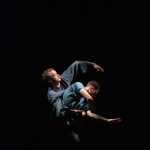 The first dance was ‘Ripple’, an hypnotically lyrical piece choreographed by Xie Xin. In this dance, the dancers became the sea, constantly moving, swelling and subsiding, especially through the movement of their arms. Although quite a bit of the dance was scored for the whole troupe, there were several duets, in which a hand would reach out towards the partner’s hand, only to be retracted before they could touch.
The first dance was ‘Ripple’, an hypnotically lyrical piece choreographed by Xie Xin. In this dance, the dancers became the sea, constantly moving, swelling and subsiding, especially through the movement of their arms. Although quite a bit of the dance was scored for the whole troupe, there were several duets, in which a hand would reach out towards the partner’s hand, only to be retracted before they could touch.
 This was followed by ‘Bradley 4:18’, inspired by a poem by Kate (Kai) Tempest, and choreographed by Maxine Doyle with music composed by Cassie Kinoshi. Here there was much more evidence of male angst and of frustrated isolation, with a recurring motif of running full tilt around the stage, and ocasional desperate tearing off of garments. But there were also moments indicating trust and there was some resolution as the piece progressed. The footwork throughout was clean and dynamic, and the dance ended with a startlingly dramatic leap.
This was followed by ‘Bradley 4:18’, inspired by a poem by Kate (Kai) Tempest, and choreographed by Maxine Doyle with music composed by Cassie Kinoshi. Here there was much more evidence of male angst and of frustrated isolation, with a recurring motif of running full tilt around the stage, and ocasional desperate tearing off of garments. But there were also moments indicating trust and there was some resolution as the piece progressed. The footwork throughout was clean and dynamic, and the dance ended with a startlingly dramatic leap.
Both pieces started with film material, in which we saw the dancers rehearsing and the choreographers being interviewed about their work. It’s quite difficult to explain exactly why, but it seemed right to me that the choreographers of both pieces were women. Although the dances were full of boyish energy and masculine strength, there was also a certain grace and tenderness to the works, particularly in the more lyrical moments, that seemed to be particularly in keeping with a feminine creativity. That is not to say, of course, that such qualities cannot be found in male-created choreography; it was just that in these pieces, the focus had, for me, a feminine slant.
All the way through, the bodies appeared to have no weight, so that the men seemed to float off the floor or, as quite frequently occurred, slide effortlessly over it. Added to this was the astonishing flexibility of their bodies, raising the question as to whether they actually had any bones at all.
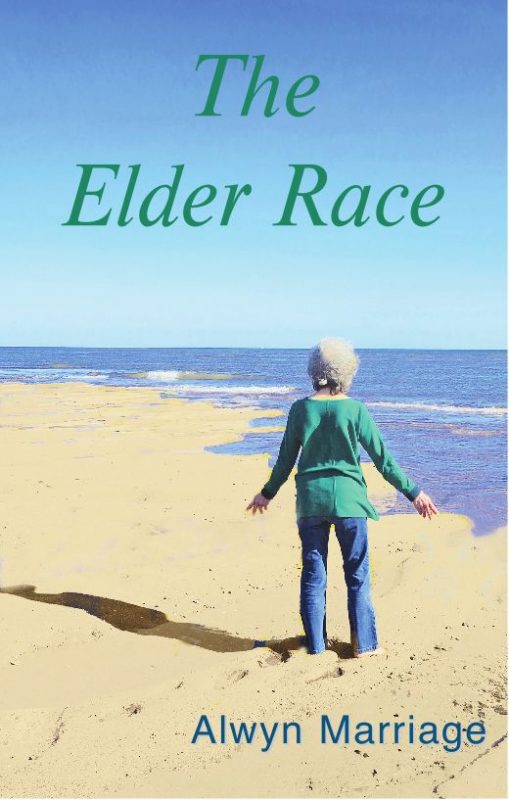
Those of you who are familiar with me or my writings will know that I am an enthusiastic fan of contemporary dance, which I feel is the closest other art form to poetry. The main character in my latest novel, The Elder Race, was a contemporary dancer, and I enjoyed writing about her recovery of agility and strength on a Cornish beach after a period in which she had had little opportunity to dance. I have a feeling that some of the BalletBoyz would have enjoyed the dances she choreographed to the accompaniment of the sound of waves and cry of gulls. In any case, I like to think so.
Comments closed I was never particularly keen on brass instruments until I met the man who was destined to be my husband. To my delight, he actually serenaded me on his trumpet with Caro mio bien, … and my life was changed for ever.
I was never particularly keen on brass instruments until I met the man who was destined to be my husband. To my delight, he actually serenaded me on his trumpet with Caro mio bien, … and my life was changed for ever.
However, he was shy about playing if anyone else could hear him, so it took quite a lot of persuasion to get him to join the Kingsbridge Silver Band. Once there, however, he started to enjoy himself so much that I reckoned it might be worth joining in the fun. I therefore borrowed a flugel horn and, after a few shaky weeks (I’m sure you know that a flugel horn played badly can sound unnervingly like a cow farting!) I joined the band as well. My moment of glory arrived in 2016 when I won  the band’s cup for the player who had made the most improvement; but I’m sure that was only because I had started from such a low base!
the band’s cup for the player who had made the most improvement; but I’m sure that was only because I had started from such a low base!
Over the next few years we played in plenty of gigs: at Christmas there’s always been a huge demand 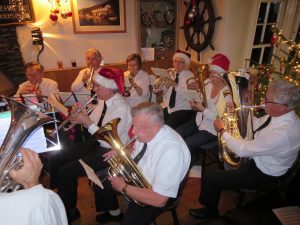 for us to play carols at pubs, open air gatherings and the local nativity play; and in summer, we expended all the breath we didn’t know we had, by processing
for us to play carols at pubs, open air gatherings and the local nativity play; and in summer, we expended all the breath we didn’t know we had, by processing 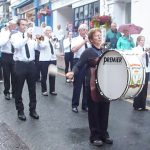 down Fore Street from top to bottom playing the Floral Dance (ad infinitum), while the rest of the town danced along in their festive clothes behind us. This is generally great fun, though the year we had to do this in pouring rain took slightly more determination. More
down Fore Street from top to bottom playing the Floral Dance (ad infinitum), while the rest of the town danced along in their festive clothes behind us. This is generally great fun, though the year we had to do this in pouring rain took slightly more determination. More 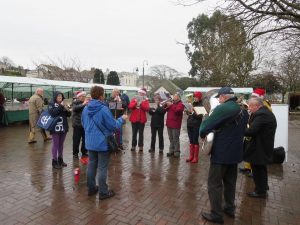 restfully, we played each summer for an open-air service at Hope Cove, put on by the Methodist church; in November we normally do our civic duty by playing for the Remembrance Day Parade; and we perform in the bandstand in Kingsbridge on various occasions.
restfully, we played each summer for an open-air service at Hope Cove, put on by the Methodist church; in November we normally do our civic duty by playing for the Remembrance Day Parade; and we perform in the bandstand in Kingsbridge on various occasions.
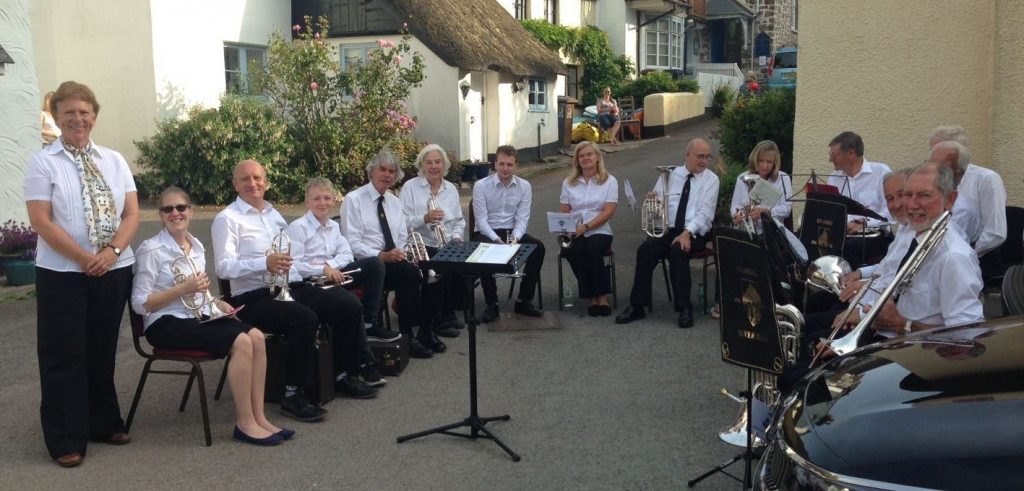
Most of the members of the band, including the wonderful band-leader, Irene, are long-time local 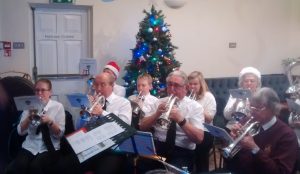 residents; and some of them have been in the band for more decades than one could imagine (over 70 years in one case!). The age range has therefore been between 12 and 90 plus.
residents; and some of them have been in the band for more decades than one could imagine (over 70 years in one case!). The age range has therefore been between 12 and 90 plus.
Not surprisingly, because of covid we have not been able to play as a band for nearly two years now; and this is particularly disappointing as this year, 2021, was our centenary year. The Kingsbridge Silver Band might, in fact, be the only band in the country that, until the pandemic, has played without a break for 100 years, as the practices and some gigs continued right through both world wars.
We had hoped to celebrate the centenary in style, but not only was that not possible, but we also got almost to the end of the year without playing together once. Fortunately, we managed a couple of outdoor events this December, and are now all hoping against hope that we can resume normal activities before TOO long. With some luck and imagination, we might even find a creative way to make up for our disappointment over the centenary with a delayed celebration in the next year or two.
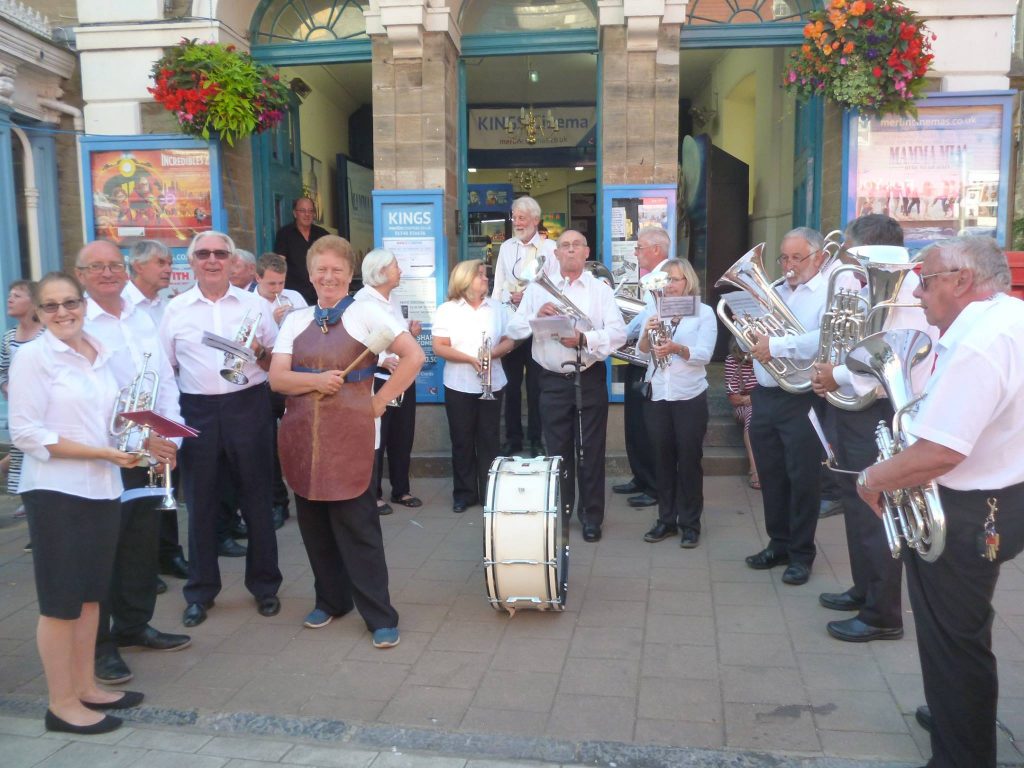
Happy New Year to you all, and may you make music, sweet or otherwise, in 2022.
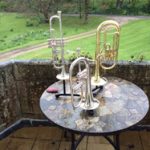


After weeks of depressing news, wet weather and dark skies, temporary relief arrived in the form of SNOW. It wasn’t half-hearted; it wasn’t wet and slushy; it wasn’t accompanied by biting winds. What’s more, it fell, conveniently, on a Sunday morning. With no home-schooling, no Zoom meetings scheduled, no piles of papers waiting to be processed, children and adults tumbled joyfully out from their warm homes to build a nation of snowmen (snowpeople?) and the occasional snowdog. The sky was light, the grime of modernity was whitewashed over and all traffic ceased, as the ludic took over from the worried and depressed.

Our own creation sported an organic carrot nose and a red plant pot hat and settled happily on our white lawn.
Never have I seen so many snowmen. Every garden sported one, the pavement was littered with all shapes, sizes and genders of snow-white people and animals, and on the downs it looked as though there had been an alien invasion.
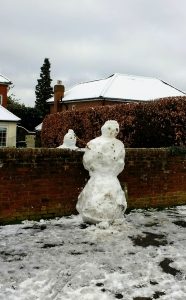


… And then the thaw set it. Slowly, sadly, the brave white creatures shed tears. Inevitably their beauty faded away, as the whole world returned to the normal mix of good, bad and indifferent. Consequently, there are now damaged snow-beings in all our gardens and limping their way to nothingness on the downs.

What is to be done? Obviously this isn’t a very important, or even sensible question, and we all have more pressing concerns on our minds at present. But after providing us with so much fun and delight last weekend, I think we owe it to them to at least consider a graceful demise.
One possibility to would to use them as wintry Aunt Sallies, and compete with each other in aiming snowballs at them until they surrender. This is not a great idea, however, first because if there were enough snow to make snowballs, most members of the tribe would still be confidently displaying their handsome shapes, so such a massacre would be premature; and secondly because one doesn’t really want to encourage any such form of aggression and war-play.
We could rush out and try to sculpt the remaining pillars into interesting new forms; but the moment has passed: we are back at work, the pristine white snow has been replaced with a patina of mud-speckling, grit and grass.
It might be possible to lift the whole item into a bucket, imprison it with a lid, and keep the soft snow-melt for future use, but that would not be a very dignified end for a noble creature; and the number of buckets that might be needed would get in the way in the garden.
If you’ve got a good idea for a worthy sequel to our fun and games last weekend, please let me know. But in the meantime, I intend to look out of my window at our snowman with affection each day, watch him diminish and melt down into the earth, to nourish new life and then be replaced by welcome signs of spring.

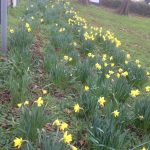
Literature festivals are important for writers; and, more specifically, poetry festivals are precious for poets. They provide, of course, one of the most successful arenas for selling our books and introduce us to new audiences. They also provide opportunities for us to hear the work of other writers and discover good books that hadn’t crossed our desks before. They create space to relax, have fun and make new friends.
This past autumn, as usual, there has been a good crop of festivals for our delectation. However, in a difficult climate for the Arts, some of these are at risk, and others have had to call a halt to their activities. I attended two festivals in Italy and two in England, so will report, briefly on those, and on their chances of survival.
Villa Pia, Umbria
 The first wasn’t, strictly, a festival but a Ways with Words house party at Villa Pia, a beautiful old house in Italy. My reason for going was that I had never been able to get to one of these holidays before, and it was advertised that this would definitely be the last one. Sadly, Kay Dunbar, who with her husband Steve Bristow has been the instigator, organiser and inspiration behind these residential literary holidays, is unwell and
The first wasn’t, strictly, a festival but a Ways with Words house party at Villa Pia, a beautiful old house in Italy. My reason for going was that I had never been able to get to one of these holidays before, and it was advertised that this would definitely be the last one. Sadly, Kay Dunbar, who with her husband Steve Bristow has been the instigator, organiser and inspiration behind these residential literary holidays, is unwell and 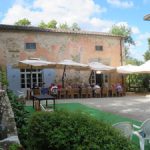 therefore unable to continue in the rôle she has so ably filled for nearly twenty years. Several of the guests had been back year after year, some staying for two weeks, rather than the one we managed.
therefore unable to continue in the rôle she has so ably filled for nearly twenty years. Several of the guests had been back year after year, some staying for two weeks, rather than the one we managed.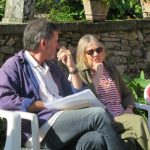
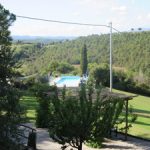
 There was a writer in residence, Mark McCrum, who was generous with his time and encouragement; there were Italian lessons on offer, and there was a day trip to San Sepulchro. Apart from those pleasures, there was time to relax (and in my case to get some writing done), beautiful countryside to explore, a deliciously warm swimming pool and fantastic food. There was, naturally, some sadness that such a lovely annual event was coming to an end – but I was just pleased that I’d finally managed to make it at the eleventh hour.
There was a writer in residence, Mark McCrum, who was generous with his time and encouragement; there were Italian lessons on offer, and there was a day trip to San Sepulchro. Apart from those pleasures, there was time to relax (and in my case to get some writing done), beautiful countryside to explore, a deliciously warm swimming pool and fantastic food. There was, naturally, some sadness that such a lovely annual event was coming to an end – but I was just pleased that I’d finally managed to make it at the eleventh hour.
Poetry on the Lake, Orta San Giulia, Italy
The other Italian event was the wonderful Poetry on the Lake at Orta San Giulio in northern Italy, which I have attended for most of the last few years. Many of us first attended this festival when we were successful in the poetry competition that preceded it each year; and then we became addicted and continued to travel to Italy each autumn for our annual fix, even without the carrot of competition success. For several years both the last Poet Laureate (Carol Ann Duffy) and the National Poet of Wales (Gillian Clark) used to attend; but they were not there this year.

Orta is a very beautiful small town on the edge of enchanting Lake Orta, the smallest and most westerly of the northern Italian lakes. Although various members of the public, and some school parties from Milan do turn up to Poetry on the Lake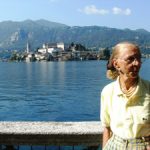 , unlike most other poetry festivals, it is not primarily a public event, though we are always pleased to see the delightful Countess who comes to listen to us each year.
, unlike most other poetry festivals, it is not primarily a public event, though we are always pleased to see the delightful Countess who comes to listen to us each year.
Instead it is a convivial get-together of poets, who read to each other at a number of events over the weekend and catch up with each other’s news. The organisation is always unpredictable and exciting, and most of us have learned that, whatever the official programme suggests, one should never turn up at a reading without a batch of poems secreted in one’s pocket. One morning of the festival is spent walking on the Sacro Monte, where we stop at each of the various shrines to read poetry.
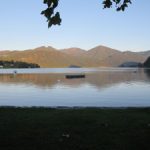

My husband and I generally drive down to Orta in our little campervan, and stay at the lakeside campsite just outside town. The walk into town and back for events is easily compensated for by the magic of waking up to sunrise over the lake, and the joy of swimming in the warm soft water each day.
So, is this a festival that is ending or continuing? Well, the rumours were that this was to be the last 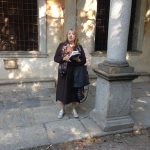 one, and this was even announced in a poetry magazine over the summer. When questioned, however, the festival organiser, Gabriel Griffin, prevaricated. No, the format would not be repeated in future, and there would certainly not be another competition. But maybe, just maybe, it was just possible that something different might happen. Who knows? But even if it does not continue, many of us have hugely enjoyed returning to Orta each year and meeting up with poets who have become firm friends.
one, and this was even announced in a poetry magazine over the summer. When questioned, however, the festival organiser, Gabriel Griffin, prevaricated. No, the format would not be repeated in future, and there would certainly not be another competition. But maybe, just maybe, it was just possible that something different might happen. Who knows? But even if it does not continue, many of us have hugely enjoyed returning to Orta each year and meeting up with poets who have become firm friends.
Torbay Poetry Festival

I was back in England in time for the Torbay Poetry Festival, one of the friendliest festivals of the annual calendar. And this time, sadly, it really was the last one. Patricia and William Oxley have run the weekend festival for nineteen years, but this year they did not manage to secure Arts Council funding. I have read at the festival several times in the past, but this year I went to enjoy other people’s work. Some highlights this year were readings by Laura Potts and Imtiaz Dharker and a fascinating presentation on John Betjeman by the president of the Betjeman Society. (Yes, I know: Betjeman isn’t my favourite poet either; but it really was a most interesting and entertaining presentation and I ended up feeling friendlier to Betjeman than I had before).
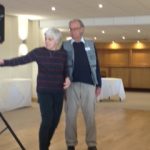
I’m delighted to say that although the Torbay Poetry Festival will be no more, the poetry magazine, Acumen, also edited by Patricia Oxley, continues to flourish. Also, in terms of festivals, there are new ones each year, including the Teignmouth Poetry Festival, just along the coast, which is going from strength to strength and the more established Exeter Poetry Festival.
Poetry at Aldeburgh
Finally to Aldeburgh, which has been home to a poetry festival for years. When the plug was pulled on the old Aldeburgh Poetry Festival a few years ago, fans were so outraged that they decided to continue in an amateur, not-for-profit capacity, without financial backing. Presumably because of the lack of funding, Poetry in Aldeburgh does not, in general, attract the very biggest names; but it presents a cornucopia of equally good, if slightly less well-known poets.
 I was one of the poets reading for the launch of Coast to Coast to Coast at Aldeburgh, for which a number of us wrote poems from locations all around the coast of the British Isles. The resulting reading gave a beautiful feeling of embracing the whole of these islands. My own poem was written on Halwell Point beach, in the Salcombe Estuary in Devon.
I was one of the poets reading for the launch of Coast to Coast to Coast at Aldeburgh, for which a number of us wrote poems from locations all around the coast of the British Isles. The resulting reading gave a beautiful feeling of embracing the whole of these islands. My own poem was written on Halwell Point beach, in the Salcombe Estuary in Devon.
One of the highlights of this weekend was a dramatised reading of T S Eliot’s The Waste Land. I greatly enjoyed Martin Shaw’s story-telling session and his joint presentation the next day with the 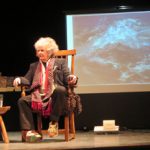 artist and sculptor Maggie Hamlyn, who stepped in at the last minute when Gillian Beer was unwell. The Ambit cocktail party was also highly enjoyable, giving the opportunity to catch up with people who most of the time were rushing from one event to another.
artist and sculptor Maggie Hamlyn, who stepped in at the last minute when Gillian Beer was unwell. The Ambit cocktail party was also highly enjoyable, giving the opportunity to catch up with people who most of the time were rushing from one event to another.
Poetry in the Pink, Pembroke College Oxford

While most of these festivals are residential, there are others that are on-going. Among these is Poetry in the Pink at Pembroke College, Oxford, organised by Peter King, which brings good poetry to the dreaming spires on a regular basis. I was delighted to read there this last month, and have every confidence that, unlike some of the other festivals I’ve described, the future of this one is secure.
Looking ahead
This spell of festivals ended with a meeting in Glastonbury to plan, with a group of Poets for the Planet, for an event we will be presenting at the Lyra Festival in Bristol in March. By then we will be into a new year of poetry events, and our diaries, which are already filling up with next year’s poetry events, will sparkle with pleasures still to come. In the meantime, it’s good to know that even when it’s so hard to get financial support for such important events as poetry festivals, they can continue to succeed, foster new talent, encourage good writing and bang the drum for poetry in the dark days of political upheaval and tragedy.
Comments closed
I happened to find myself in Assisi on the day of the international School Strikes demanding action on climate change, led by the Swedish teenager, Greta Thunberg; and I felt that the theme fitted well with the Franciscan ethos that is still evident in Assisi.
There are various reasons why a visit to the Church of St Francis in Assisi is inspiring, the chief one, as far as I am concerned, being because of the number and quality of the paintings by some of my favourite artists, that adorn the walls, including Cimabue’s portrait of St Francis, which forms part of his majestic painting of the Virgin and Child with angels.  Nowhere else can one find so many frescoes by Giotto and Cimabue and I could (and do when possible) spend many hours contemplating the vision of these artists. This does not mean, however, that I am entirely uncritical of the treatment of all the subjects portrayed.
Nowhere else can one find so many frescoes by Giotto and Cimabue and I could (and do when possible) spend many hours contemplating the vision of these artists. This does not mean, however, that I am entirely uncritical of the treatment of all the subjects portrayed.
For most of us, Francis is renowned for his love of nature and his respect for all Creation, and at a time when so much of our natural environment is bespoiled or at risk of extinction, these aspects of his story are more attractive than ever. Born into a well-to-do family and  initially living a life of pleasure and ease, Francis had an epiphany that caused him to give up all worldly wealth and privilege to become a humble friar. It may well be that he appeared at a point in history when his message was needed, and he simply ignited a fuse that was ready to burst into life; but he was also clearly a charismatic character, who quickly attracted huge numbers of followers and gradually formed what became known as the Franciscan Order. As is often the case with these special personalities, stories accrued around the basic facts of his life, and a number of miracles were ascribed to him both during his lifetime and afterwards.
initially living a life of pleasure and ease, Francis had an epiphany that caused him to give up all worldly wealth and privilege to become a humble friar. It may well be that he appeared at a point in history when his message was needed, and he simply ignited a fuse that was ready to burst into life; but he was also clearly a charismatic character, who quickly attracted huge numbers of followers and gradually formed what became known as the Franciscan Order. As is often the case with these special personalities, stories accrued around the basic facts of his life, and a number of miracles were ascribed to him both during his lifetime and afterwards.
The fact that St Francis was a remarkable and inspiring man doesn’t mean that we have to accept the veracity of all the stories portrayed, lock, stock and barrel, though the fact that some of these are far-fetched is not necessarily the fault of the artist, who was simply reproducing myths and legends that were handed down through haggiography or folklore.
The lower basilica in Assisi contains twenty eight frescoes painted either entirely by Giotto or, possibly in some cases, by his associates. These images relate stories from the life of St Francis, the majority of which are more or less credible, while one or two are rather less so. Among the examples of these rather more ‘magical miracles’, I would include the fresco that shows the brothers in Rivotorto observing Francis riding about in a fiery chariot, when he was at the time, in fact, safely earthbound and praying in Assisi. Then, in another picture, the artist portrays the friars watching Francis ascending heavenward in a cloud.
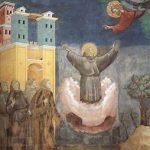
In fact, the life St Francis is so inspiring in itself that there are not as many far-fetched miracles portrayed here as is the case with some of the other saints. To paint Francis hearing a voice speaking to him from the crucifix does not cross the credibility line because it is not implied that the voice would have been audible to anyone else. And many of the other images show striking and unusual events that are not beyond the bounds of possibility, such as Francis preaching confidently before Pope Honorius III, Francis giving his cloak to a poor and destitute nobleman, Francis returning his clothes and possessions to his father or even, with a touch of poetic license, Francis preaching to the birds.
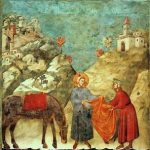

But the miracles that impress me most in the story of this humble saint, also handed down to us in the story of St Francis, don’t relate magical incidents, but the sort of miracles we are more likely to encounter ourselves. Those that are illustrated here include the following:
As well as these miracles, illustrated in the frescoes of the life of St Francis, I believe that we frequently witness miracles in our daily lives, but sometimes fail to realise the wonder of what we are seeing. The fact that a tiny seed can fall into the earth then grow into a mighty tree is nothing short of a miracle; the birth of a baby is a miracle; reconciliation between people who have been in conflict is a miracle, and love that lasts through thick and thin is a miracle. And, as I have mentioned, it is nothing short of a miracle that a young teenager can motivate so many people all around the world, to rise up and demand action on climate change, and can also be invited to meet some of the movers and shakers of the world and speak with authority at international events.
And, as I have mentioned, it is nothing short of a miracle that a young teenager can motivate so many people all around the world, to rise up and demand action on climate change, and can also be invited to meet some of the movers and shakers of the world and speak with authority at international events.
Having recognised these as miracles, I am left wondering whether there is any hope that we might witness an even greater miracle that will save the planet before it is too late. Inspired by a 13th century itinerant preacher, can we, perhaps, hope for the miracle that would bring about the agreement of world leaders to make immediate and radical adjustments to policy and commerce, along with the even greater miracle that would lead all of us to love and respect our environment to such an extent that we are prepared to change our behaviour and our lifestyles in whatever ways are necessary for the survival life on earth?
Comments closed
Last summer, Mark Oakley, who was at that stage still Canon Chancellor of St Paul’s Cathedral before his move to Cambridge, invited me to the cathedral to see the two Bill Viola installations/films there. ‘Martyrs: Earth, Air, Fire, Water’, was installed in the cathedral in 2014. Set across four vertical plasma screens, it depicts four individuals being martyred by the four elements. The work is silent and deeply moving.

The second video, ‘Mary’, was installed in the cathedral in 2016, and is a celebration of women, using depictions of Everywoman. I found both artworks extremely moving, so jumped at the opportunity to visit the Royal Academy last week for their exhibition, ‘Bill Viola and Michelangelo: Life Death Rebirth’.
Despite mixed reviews, the exhibition did not disappoint. The main exhibits were by Bill Viola, but they were accompanied by a number of small drawings by Michelangelo. Both artists, of course, demonstrate the beauty and power of the human body, particularly the male body. Michelangelo’s specific meditations on the Resurrection become, in Viola’s work, celebrations of both transformation and physical rising.
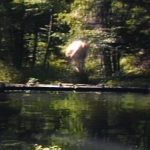
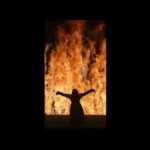
The theme of water is so universally present in these works that it almost appears to be an obsession, but it is clearly a metaphor both for life and also for transcendence. Walking through the semi-darkness, watching the videos, some of which take around a quarter of an hour to play, one is transported into 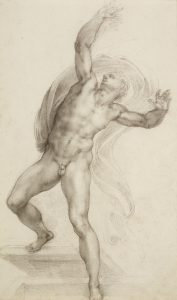 Viola’s world and receives a glimpse of his spiritual awareness. The cleansing of one’s normal attention also made the Michelangelo drawings that much more striking, as one became conscious of the way in which the artist conveys so much of the important essence of the figures with so few strokes of the brush or pen, whether it be a depiction of Christ’s crucifixion, the risen Christ (pictured right) or the tenderness of a nativity scene.
Viola’s world and receives a glimpse of his spiritual awareness. The cleansing of one’s normal attention also made the Michelangelo drawings that much more striking, as one became conscious of the way in which the artist conveys so much of the important essence of the figures with so few strokes of the brush or pen, whether it be a depiction of Christ’s crucifixion, the risen Christ (pictured right) or the tenderness of a nativity scene.
Before I went into the exhibition, a couple of men in the café told me that they had got round it in 10 minutes. I was therefore surprised to find myself still in the darkened rooms after an hour an a half; and even more surprised to find that the images, and Bill Viola’s meditation on life and transcendence, travelled with me when I left.
Comments closed